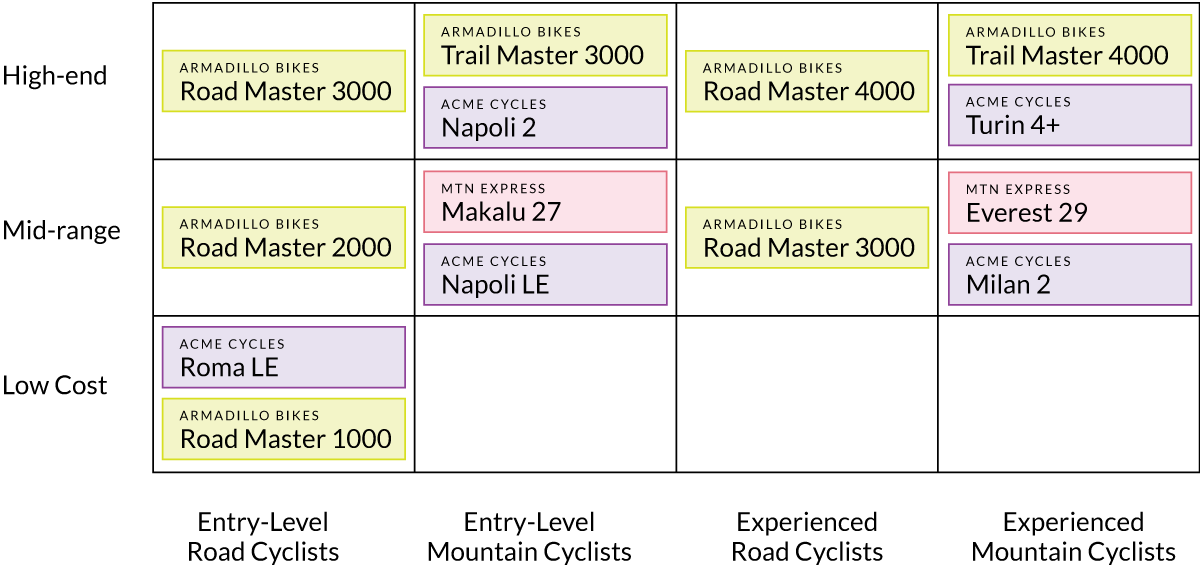 Deciding what products and features to offer to your customers requires a clear understanding of your markets. Once you identify market segments, you can propose different product configurations to meet each segment's needs. You can perform an analysis of your products side-by-side against your competition in each segment to see how the segment is being served and find opportunities for new and improved products.
Deciding what products and features to offer to your customers requires a clear understanding of your markets. Once you identify market segments, you can propose different product configurations to meet each segment's needs. You can perform an analysis of your products side-by-side against your competition in each segment to see how the segment is being served and find opportunities for new and improved products.
Defining your market segments and aligning your organization around them to justify new products is no easy task. Nevertheless, alignment on market segments is essential to speed up the brainstorming and make decisions around your products' next generation. Below we outline an approach in deciding what products to offer to your markets.
Defining your market segment
There are well-known methods for identifying and segmenting your market. Product and marketing teams define their market segments based on a combination of the following characteristics:
- Geographic: such as country and city a person works or lives
- Demographic: such as life stage, gender, and income
- Psychographic: such as lifestyle, and social behavior or culture
- Behavioral: such as purchasing habits and how a person uses a product
Deciding how to break out the segment depends on the product and the needs of the market. For example, a bicycle manufacturer may be interested in a mix of demographics and psychographics. With this information, your business can estimate the market size and analyze features, prices, and volumes to produce for that market.
Defining the market segment includes identifying the customer and their problems, wants, and needs. For example, a bicycle manufacturer may segment its market based on road cyclists and mountain cyclists. In each segment, you can have entry-level and experienced cyclists. Then they can identify their high-priority needs, wants, or the problems they may be looking to solve for each. An experienced road biker would potentially push for that little extra speed. That means the weight and aerodynamics of the bike are essential. However, the entry-level road biker may be more cost-conscious and would like a comfortable bicycle to start their biking journey.
Once market segments are defined, communicated, and agreed on across the stakeholders, it will set the stage for identifying strategies to enter the market with new or improved products. The market segment document is a living one where the team will refer to or improve as more information is gathered and questions are raised during the product lifecycle.
Visualizing products within a market segment
Marc H. Meyer and Alvin P. Lehnerd introduced the Market Segmentation Grid in "The Power of Product Platforms." The Market Segmentation Grid is an effective way to visualize the market segment and the way it is being served. The Market Segmentation Grid has the market segments as columns and its price and performance on the rows. Naturally, products will be higher in price as their performance increases. You may categorize this as "Good, Better, Best," "low-end, mid-range, and high-end," or "low-cost, high-cost."
In our bicycle example, you can depict the Market Segmentation Grid as follows:

Analyzing the landscape
Once you define your Market Segmentation Grid, you can now map your products alongside your competitors' products to see how the market is served in this space.
The diagram below shows an example of our Bicycle manufacturer and how currently the competition covers the market. Our manufacturer, Armadillo Bikes, is servicing the Entry-Level market, but it seems that there may be an opportunity to serve the Entry-Level, Low-Cost market. The mid-Range market is crowded, and if they can find a clear differentiation, then maybe that would be another opportunity for Armadillo Bikes.

You can now decide how to enter the market either with new products or upgrade your current products to be more competitive. Having a canvas such as the Market Segmentation Grid will give you a high-level overview of how your products are servicing the market alongside your competition. You can also take this further. Having references back to the market segment documents and product content will allow you to drill down into more information and zoom back into this chart as part of your conversation or collaboration.
Conclusion
The Market Segmentation Grid in "The Power of Product Platforms" focuses on introducing an approach for creating product platforms. But it can also be a powerful tool to communicate your companies position in the market and collaborate on how best to approach the market from a customer's perspective.
Market Segmentation Grid is more effective if backed by a common and deeper understanding of each market segment. By detailing each market segment profile and aligning stakeholders around it, collaborating on where the opportunities lie becomes more accessible and faster.
With an understanding of the market segment needs and visualizing the landscape using the Market Segmentation Grid, product teams can define products that best meet that segment needs as a team and devise a strategy to enter that market in stages.
Join the Gocious journey in making better products by using advanced product management systems
Try 30 day free trial of Gocious


